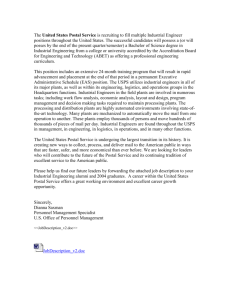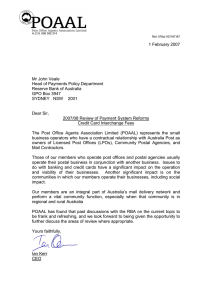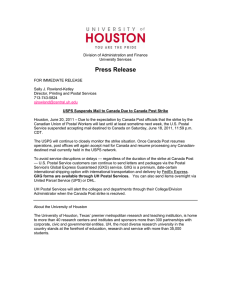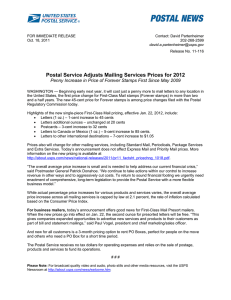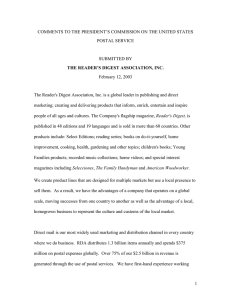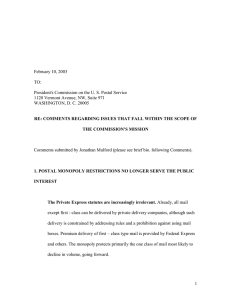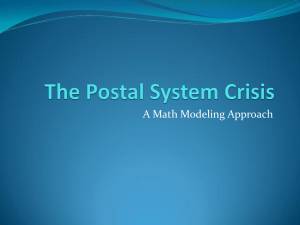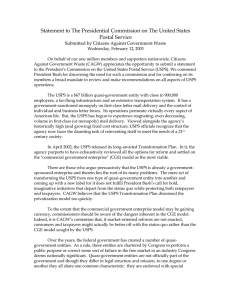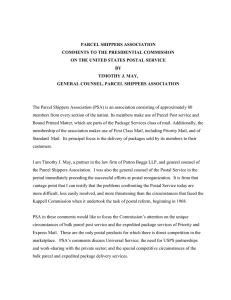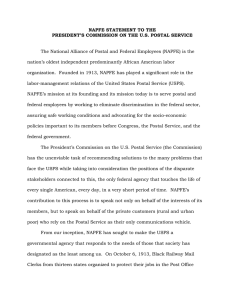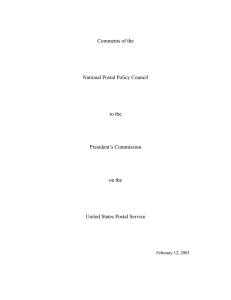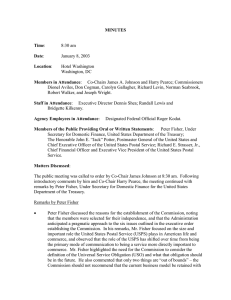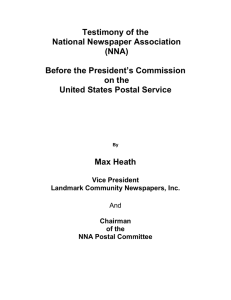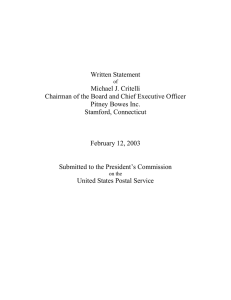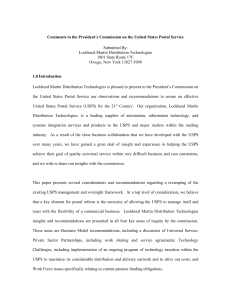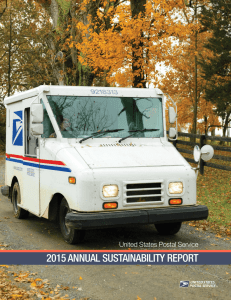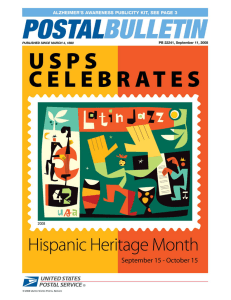Business or Public Good: It’s Not Just about Saturday Delivery
advertisement
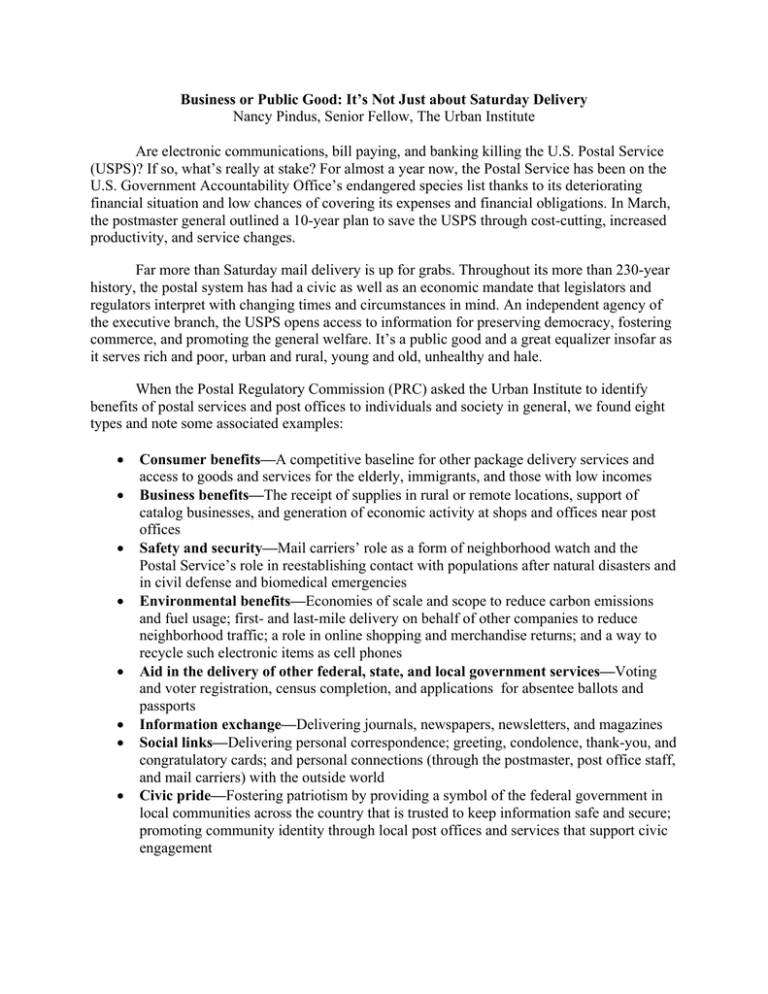
Business or Public Good: It’s Not Just about Saturday Delivery Nancy Pindus, Senior Fellow, The Urban Institute Are electronic communications, bill paying, and banking killing the U.S. Postal Service (USPS)? If so, what’s really at stake? For almost a year now, the Postal Service has been on the U.S. Government Accountability Office’s endangered species list thanks to its deteriorating financial situation and low chances of covering its expenses and financial obligations. In March, the postmaster general outlined a 10-year plan to save the USPS through cost-cutting, increased productivity, and service changes. Far more than Saturday mail delivery is up for grabs. Throughout its more than 230-year history, the postal system has had a civic as well as an economic mandate that legislators and regulators interpret with changing times and circumstances in mind. An independent agency of the executive branch, the USPS opens access to information for preserving democracy, fostering commerce, and promoting the general welfare. It’s a public good and a great equalizer insofar as it serves rich and poor, urban and rural, young and old, unhealthy and hale. When the Postal Regulatory Commission (PRC) asked the Urban Institute to identify benefits of postal services and post offices to individuals and society in general, we found eight types and note some associated examples: • • • • • • • • Consumer benefits—A competitive baseline for other package delivery services and access to goods and services for the elderly, immigrants, and those with low incomes Business benefits—The receipt of supplies in rural or remote locations, support of catalog businesses, and generation of economic activity at shops and offices near post offices Safety and security—Mail carriers’ role as a form of neighborhood watch and the Postal Service’s role in reestablishing contact with populations after natural disasters and in civil defense and biomedical emergencies Environmental benefits—Economies of scale and scope to reduce carbon emissions and fuel usage; first- and last-mile delivery on behalf of other companies to reduce neighborhood traffic; a role in online shopping and merchandise returns; and a way to recycle such electronic items as cell phones Aid in the delivery of other federal, state, and local government services—Voting and voter registration, census completion, and applications for absentee ballots and passports Information exchange—Delivering journals, newspapers, newsletters, and magazines Social links—Delivering personal correspondence; greeting, condolence, thank-you, and congratulatory cards; and personal connections (through the postmaster, post office staff, and mail carriers) with the outside world Civic pride—Fostering patriotism by providing a symbol of the federal government in local communities across the country that is trusted to keep information safe and secure; promoting community identity through local post offices and services that support civic engagement Social benefits, though hard to quantify, contribute to individual and community wellbeing. But even as researchers make strides in measuring these benefits in a range of industries and social ventures and in getting the results used to make practical decisions, a key question remains—Who pays for all of these benefits? In the case of the public goods provided by the USPS, does it make sense to keep ruling out a federal subsidy? If this option raises concerns about expanding the role of government, the potential impact of market-based decisions—whether no Saturday mail service, no last-mile delivery to remote areas, or post office closings—must be weighed along with the USPS’s challenging dual identity as a public service meeting multiple demands and a business that must pay its own way. It’s natural to want full service without paying the full costs. But if we insist on Saturday delivery, convenient local post offices, reduced rates for nonprofit and community organizations, and other social benefits as the right of citizens, we can’t expect the USPS to operate in the black as mail volume drops. A wiser question than “Can’t we pay less for what we want?” may be “What are taxpayers willing to give up or to pay, especially since those who stand to lose the most are the most isolated and vulnerable among us?” Nancy Pindus and her colleagues at the Urban Institute just completed a study for the Postal Regulatory Commission on challenges facing the U.S. Postal Service. Read the study.
